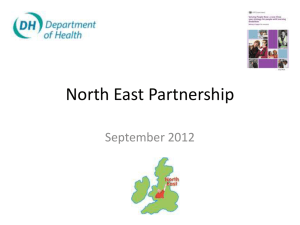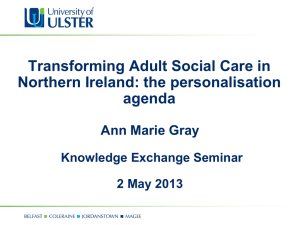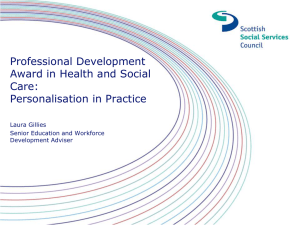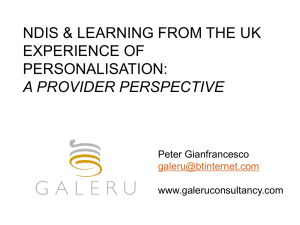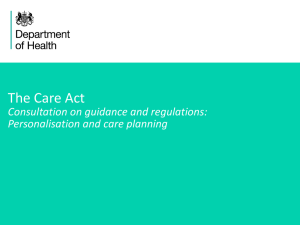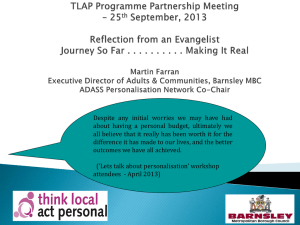4. Colin Slasberg - Personalisation
advertisement
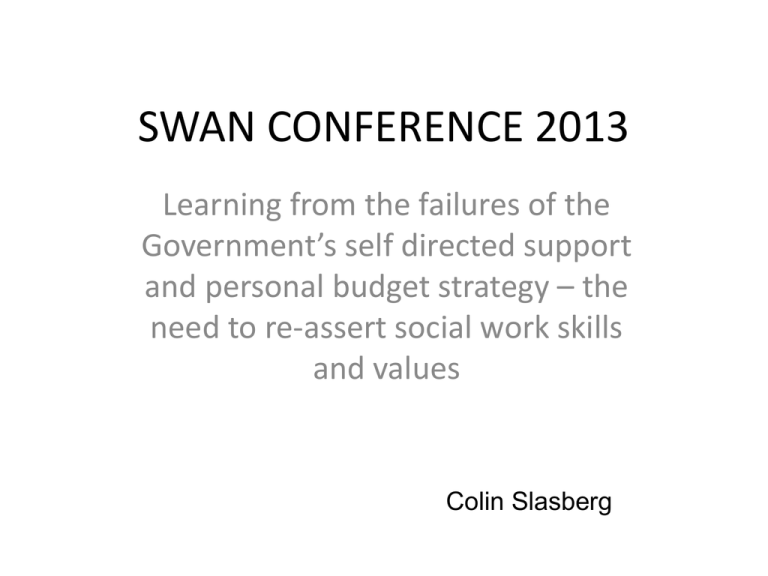
SWAN CONFERENCE 2013 Learning from the failures of the Government’s self directed support and personal budget strategy – the need to re-assert social work skills and values Colin Slasberg What is meant by personalisation • Personalisation is taken here to mean having supports that fit around the person in contrast to the person having to fit within services • Whilst not a sufficient condition to enable all older and disabled people to have the independence and well being they can reasonably expect as it also important to have sufficient resource, it is a necessary condition for three reasons; • even if resources are sufficient, they must function correctly • personalisation ensures the best possible use of limited resources • it will generate information about the gap between needs and resources to inform the democratic public spending decision making processes The need to learn from current failures • Personalisation, with different words, has been a policy objective for over 40 years, from Care in the Community, to Community Care and now Self Directed Support. However, success on anything other than a small scale has not been achieved • If we learn the right lessons from the failures both of Community Care and Self Directed Support, it will be possible to achieve sustainable personalisation • The following sets out why building on the right lessons from past and current attempts it will be possible to build a sustainable strategy The evidence of failure of the government’s SDS strategy • Up-front allocations, the cornerstone of the policy, need to be close to what people actually get. In reality, the two bear no relationship to each other; • A large number of FOI’s now show that they differ by between 2 and 3 fold • The RAS is like a “cog spinning within a machine with which it does not connect” – Clements and Series • A massive cost in bureaucracy. Since 2007/8; • 8.6% increase in staffing • 16.5% loss in assessment and care management activity • 47% loss in people getting ‘professional support’ • Outcomes have not been improved. An impression of success is sustained through publicising the success of small numbers able to use a direct payment and re-labelled a personal budget. Why is SDS failing – one Objectivity versus accuracy • Social care needs arise from the complex interaction of a number of highly variable factors. This makes them and their story unique to each person. • Up front allocations rely upon categorising needs, and then attaching average costs to each category. This formulaic approach gives an appearance of objectivity. However, it inevitably contains error, the only question being how great is the error. • Social care works in an environment where deliberate error is not acceptable. Instead, the greatest possible accuracy is required to ensure; • support plans are personalised • resource allocation decisions are lawful • scarce resources are used well Why is SDS failing – two Contradictory meanings of choice and control • The 2010 Vision for Social Care makes the following, contradictory, statements; 1. “People, not service providers or systems, should hold the choice and control about their care” 2. “We want people to have the freedom to choose the services that are right for them...” • The first belongs to a consumerist view, the customer is ‘always right’ and their control is absolute. The second acknowledges there are good and bad choices. Its core is flexibility of options with control shared between State and individual. The key issue becomes not the fact of State power, but how it is delivered. SDS left that unchallenged. • Ferguson discusses how there are two narratives re empowerment, and citing Beresford and Croft, a consumerist and a democratic model. The parallel strands in resource allocation Category of need(s) Indicative budget Person chooses supports Personal budget Resource required Amount If we are back to square one – what needs to be different to ensure personalisation of support planning 1. Free up resource base as cash to allow flexibility of options for all, notwithstanding that most will choose collective, mainstream services 2. Abandon assessment regimes based on categorising needs and create a new approach to ‘need’ that supports individual uniqueness whilst also enabling comparability for the purpose of equity,. 3. A new approach to addressing the tension between needs and resources to replace FACS. Dowson discusses the need to separate the State’s responsibility to ration resources from the support planning process, and a need to negotiate between the two. 4. Partnership between a reformed State and individual to replace self direction A new approach to identifying and prioritising needs to support person centred practice STRATEGIC OUTCOME LEVEL OF INDEPENDENCE AND WELL BEING IT IS REASONABLE FOR THE PERSON TO EXPECT GIVEN THE LEVELS AMONGST THE BROADER COMMUNITY Increasing priority PERSONAL NEEDS Personal needs derive from identifying the issues that prevent the person from enjoying the strategic outcome. Each personal need is unique. Priority is established by mapping each personal need to the appropriate universal need. The failure of FACS - rationing resources through the assessment process Needs are divided into two groups – eligible/affordable and non eligible/non affordable. With the cost of meeting needs highly variable, and a weak definition of priority bands, the definition of ‘critical’ and ‘substantial expands and contracts depending on size of budget Key Needs funded Needs 'lost to the system' Henwood and Hudson Council one/user group one Council one/user group two Critical and substantial needs Critical and substantial needs Level of resource, not eligibility criteria, determines how many needs are met Equity is spurious, hiding major inequities between user groups and councils Assessments are limited only to needs likely to be funded People are told that needs they believe they have are not needs at all Sensible, value for money spend on lower priority needs is not supported Allocating resources and person centred working Council/user group one Council/user group two Key Needs met Survival DUTY Needs not met Keeping safe Needs eligible for public funding Self worth DISCRETION • Equity is measured by the proportion of eligible needs met at the discretionary levels • The level of equity sought is secured through adjustment of budgets Self fulfilment Needs not eligible for public funding Needs that would enable a level of independence and well being above what would be expected by most people Needs that would fall to be eligible but it is appropriate and reasonable for the person or those around them to meet A new partnership - the individual, skilled practitioner and resource allocator COUNCIL CONTRIBUTION Decides 1) if plan is fit for purpose 2) how much of it to fund within cash limit PRACTITIONER CONTRIBUTION Practitioner articulates the person's thinking develop their person's thinking thinking is purpose and able to articulate their plan supports the person to The fit for Practitioner The person's Practitioner develops plan using messages the person is thinking is fit able to for purpose communicate but cannot articulate their plan A plan is fit for purpose if it will enable the person to meet their reasonable expectations of independence and well being and does so in the most cost effective way The balance of contributions of the person and the practitioner is determined only by how able the person is to create their own fit for purpose plan The person's thinking is not fit for The person purpose does not have the capacity to SERVICE USER CONTRIBUTION plan their support The practitioner can be directly employed by the council or work from an independent organisation committed to working to the agreed standards Securing better funding levels • The judicial system is not going to deliver changes to political commitment to fund social care. Despite Human Rights and Equalities legislation, neither the UK Supreme Court nor Strasbourg has any appetite to challenge democratic decision making processes. Direct engagement of the democratic process is the surest route. • The new approach to needs and resources will create information about the extent to which resources fall short of enabling all to meet their reasonable expectations of independence and well being. • This creates an opportunity to transform the politics of how needs and resources are matched strategically The prevailing strategic process of matching needs and resources This process applies under both the Community Care and the SDS regimes Govt decides tax levels and priorities for public spending Grants to council to fund social care Council decides tax levels and priorities for public spending It is a process that might be better described as the ‘political gift’ than the ‘professional gift’. Budgets for social care It is an oppressive system, with knowledge of the actual extent of need repressed. Un-met need is hidden from view and not fed back to the decision making system Support Plans created based on assessments constrained by affordability A new process that engages the democratic process Government decides tax levels and priorities for public spending Grants to council to fund social care Aggregated information about unmet needs inform decision making process about funding levels Council decides tax levels and priorities for public spending Budgets for social care Support plans that offer the best quality of life for all SU’s within available resources Further levels of resource required so all SU’s can have a quality of life comparable to the majority Support planning process identifies resources for each person to have a quality of life comparable to the majority Council decides how much to fund with regard to priority and seeking highest level of outcomes from limited resource The essential building bricks of personalised support planning on a sustainable basis • Partnership between State and individual, not self direction, with the State transforming its policies so it will be fit for the partnership • Intelligent budget holding • Skilled practice, whether provided directly by the State or on its behalf, rooted in social work skills and values The essential building bricks of independence and well being for all • All the evidence is that most people will continue to want to use collective and mainstream services. Therefore, full personalisation will call for two strands; • Personalised support planning • A network of providers commissioned to deliver personal outcomes through flexible and responsive operational capacity • Political integrity in addressing the balance of needs and resources Social Workers as activists Social Workers should seek opportunities to; • accelerate the demise of the era characterised by a ‘social care by numbers’ approach to assessment and by consumerism on the basis of its failure serve the interests of older and disabled people or deliver key policy objectives. • re-claim the territory from which their skills and values have been forced out by these strategies, but for pragmatic, not idealistic or self interested, reasons • Insist that their assessments address the whole person, and that there is honesty and transparency about how far resources fall short of meeting people’s reasonable expectations of quality of life. References • Clements and Series - Putting the Cart before the Horse: Resource Allocation Systems and Community Care http://www.academia.edu/2426190/Putting_the_Cart_before_the_Horse_Resource_Allocation_Systems_ and_Community_Care • Slasberg, Beresford and Schofield, How self directed support is failing to deliver personal budgets and personalisation ssrg.org.uk/wp-content/uploads/2012/01/Slasberg-et-al.pdf • Ferguson, Personalisation, social justice and social work: a reply to Simon Duffy; http://www.tandfonline.com/doi/abs/10.1080/02650533.2011.623771 • Dowson, Its not just about the money, www.ndti.org.uk/uploads/files/NJAMALL.pdf • Slasberg, Towards an eligibility framework that serves the interests of service users and councils, http://www.scie-socialcareonline.org.uk/profile.asp?guid=4c547abb-e747-4e4b-bad0-b28a96450fcb • Henwood and Hudson, Lost to the system, http://www.scie-socialcareonline.org.uk/profile.asp?guid=8246367e-05c4-46a9-86ad-78f0d74f0dc9
